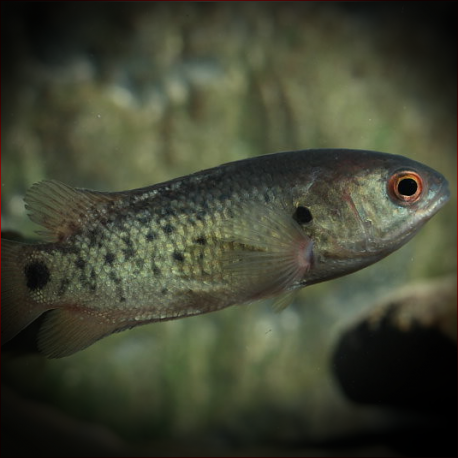More info
Datasheet
| Minimum Tank Size | 200 litres / 52.83 US gallons |
| Maximum Size | 20.0cm / 7.87inches |
| Temperature | 15°C / 59.00°F - 30°C / 86.00°F |
| Hardness | 2.02dgH / 36ppm - 25.04dgH / 447ppm |
| pH | 5.5-8.0 |
General Description
Not widely popular in the aquarium trade, the Climbing Perch, scientifically known as Anabas Testudineus, possesses an intriguing ability to survive out of water and produce audible sounds, with natural occurrences of xanthic and albino forms. The taxonomic status of its genus remains confusing due to morphological differences among populations across its wide distribution range. As a member of the Anabantidae family, it features suprabranchial organs for labyrinthine breathing, indicating its phylogenetic position within the suborder Anabantoidei.
Aquarium Setup
For a Climbing Perch, a tank setup of at least 200 litres is recommended, ideally with a soft, sandy substrate, dim lighting, driftwood, floating vegetation, and ample cover. While reports of their climbing abilities are exaggerated, a secure cover is essential due to their jumping tendencies and need for humid air. Efficient filtration is necessary, with water parameters ranging from 36-447ppm hardness, pH of 5.5-8.0, and a temperature between 15-30°C.
Behaviour
The Climbing Perch exhibits predatory behavior primarily, preying on smaller fishes, invertebrates, and mollusks. In captive groups, conflicting reports exist regarding intraspecific aggression, with some experiencing territorial behaviors while others observe a peaceful nature. Factors such as confused taxonomy, varied ecological influences, and temperature can influence their aggression levels.
Feeding and Diet
Chiefly carnivorous, this species feeds on live and frozen foods like earthworms and shellfish. In the wild, their diet includes vegetative matter like algae and rice grains, along with smaller aquatic creatures. They can be trained to accept dried foods, with preferences leaning towards pelleted products over flakes.
Reproduction & Dimorphism
Unlike most anabantoids, Climbing Perches do not exhibit parental care. Sexual dimorphism is noticeable during breeding, with males displaying reddish hues and tubercles on fins, while females appear larger and rounder, with a bulge at their vent. Spawning occurs in open water during the rainy season, with males fertilizing non-adhesive eggs that hatch and yield free-swimming fry within a couple of days.
Habitat and Distribution
The species is widely distributed across Southeast Asia, including countries like India, Bangladesh, Thailand, Malaysia, and Indonesia. Inhabiting various freshwater habitats like swamps, lakes, and rice paddies, the Climbing Perch can survive in brackish coastal environments. They are known for their ability to move across land for short distances and aestivate by burying themselves in moist ground under extreme conditions.

